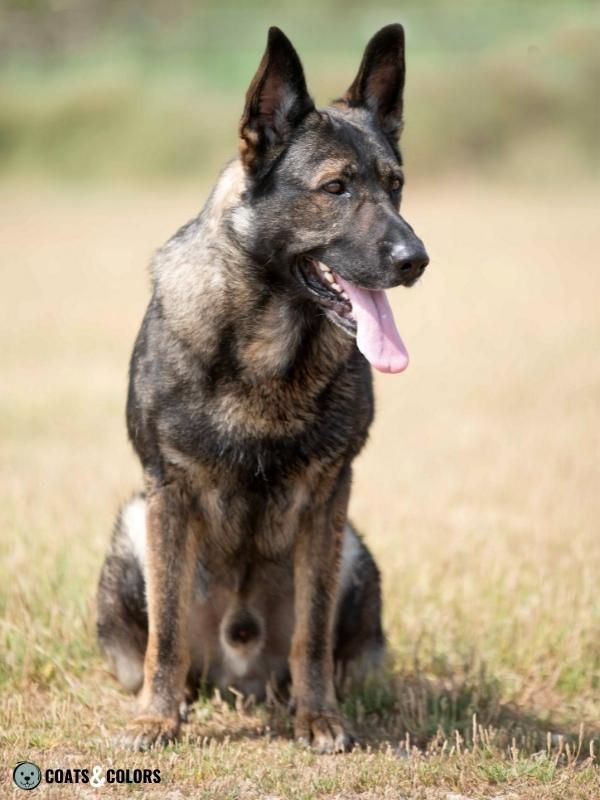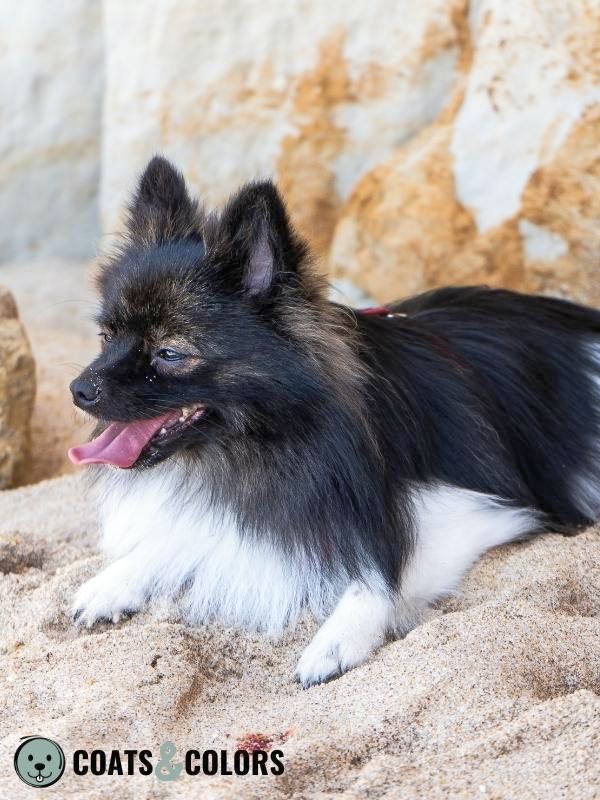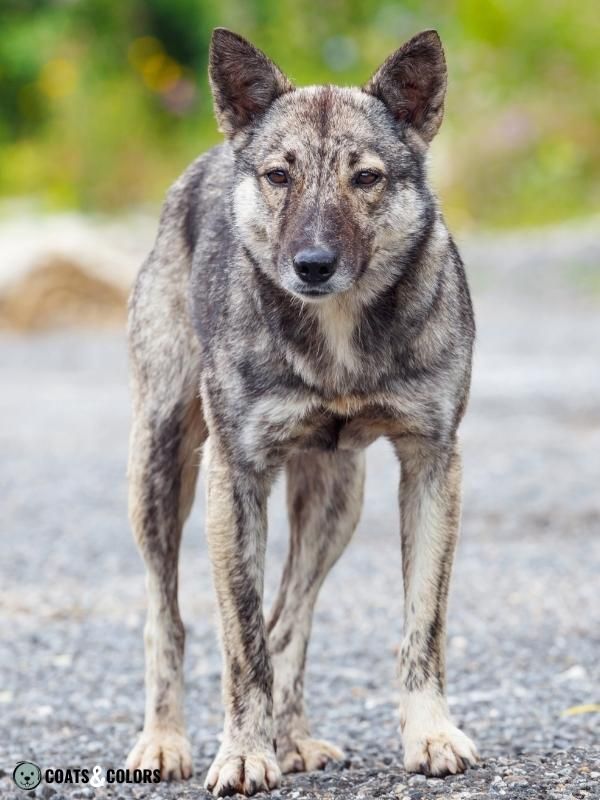Agouti is a pattern with banded hairs and dark hair tips on the dorsal area and lighter markings on the dog’s underside, muzzle, eyebrows, and chest. This phenotype is found in many wild animals and is also called wolf grey or wolf sable.
Content
What is Agouti?
Agouti causes a banded coat along the dorsal region of the torso and on the neck and head. Facial patterns range from some banded coat on the upper half of the muzzle to a long bar stretching from nose to forehead.
The banded coat is caused by alternating between phaeomelanin and eumelanin production during hair growth. Agouti produces not only dark-tipped hairs but often causes more than two bands in each hair.


The eyebrows and lower half of the muzzle as well as the ventral body areas on the lower legs, chest, throat, belly, and under the tail remain solid white, yellow, or red. Interestingly, these clear markings follow the same pattern as do tan points in black and tan dogs.
Agouti is the wild type when it comes to canine coat coloration. It is found in grey wolves and all sorts of other wild animals where it causes a dull grey or brownish appearance.

The ASIPAG allele (aw)
The A-Locus determines the temporal and spatial distribution of phaeomelanin in a variety of different color patterns.
However, these ASIP gene patterns can only be observed in dogs that are neither dominant black (KB/-) at the K-Locus nor recessive red (e/e) at the E-Locus.
The traditional testing system can only distinguish between four patterns: Ay>aw>at>a. But this test was unreliable for some breeds and could not explain why some dogs have dark shading or how a saddle pattern works.
With new research we now can detect six different patterns controlled by the A-Locus:
| ASIPDY | Ay | Dominant Yellow, Clear Sable |
| ASIPSY | Ays | Shaded Yellow, Shaded Sable |
| ASIPAG | aw | Agouti, Wolf Grey |
| ASIPBS | asa | Black Saddle |
| ASIPBB | at | Black Back, Tan Point |
| ASIPa | a | Recessive Black |
Agouti (ASIPAG or aw) is recessive to clear sable and shaded sable, but dominant over saddle pattern, tan point pattern, or recessive black.
Agouti is caused by a particular combination of two regions inside the ASIP gene:
One particular variant of the ventral promotor (VP2) produces clear phaeomelanin-pigmented areas without any banding on the dog’s muzzle, eyebrows, chest, belly, lower legs, and under the tail.
And the version of the hair cycle promotor (HCP2) found in agouti patterned dogs causes coat banding by alternating between dark and light pigment during hair growth.
This combination or haplotype (VP2-HCP2) represents the new dominant yellow allele aw. Other haplotypes represent other alleles (see the A-Locus for more info).
| Phenotype | Allele | VP | HCP |
| Dominant Yellow | Ay | VP1 | HCP1 |
| Shaded Yellow | Ays | VP2 | HCP1 |
| Agouti | aw | VP2 | HCP2 |
| Black Saddle | asa | VP1 | HCP4 |
| Black Back | at | VP2 | HCP3,4,5 |
| Recessive Black | a | (VP2) | (HCP3) |
Dogs with an aw/- genotype can be carriers for black saddle (aw/asa), tan point (aw/at) or recessive black (aw/a).
But the old testing system will report both aw/asa and aw/at as aw/at since it can’t tell the difference.
Agouti Patterns
Agouti causes some hairs to have alternating bands of eumelanin and phaeomelanin.
Usually, the banded hairs are concentrated along the dorsal region of the torso while the ventral region, cheeks, and eyebrows grow without banding. A common example of this pattern is the German Shepherd Dog (although agouti is called sable in this breed!).

But looking at a dog’s hair is not the only way to tell if a dog is truly agouti.
Agouti gives a particular facial pattern with a very dark upper half of the muzzle or more commonly a bar of dark banded hair along the ridge of the nose. In some agouti patterns, we find some lighter spectacles made of lighter-colored hairs around the eyes.


Compared to shaded sable, agouti usually seems way darker, especially in young dogs and puppies.
But the transition between a heavily shaded sable and a lighter agouti pattern is gradual and in some cases needs closer inspection. Usually, shaded sable produces a widow’s peak that does not extend beyond the eyes and onto the nose ridge like in agouti patterns.
Phaeomelanin Intensity
Phaeomelanin can be expressed in shades from white to yellow or red. This can give agouti patterned coats very different looks depending on the contrast between darker hair banding and the base color.
Keeshonds and Schnauzers in “pepper and salt” are good examples of an agouti pattern where all yellow pigment is lightened to white.



Agouti and Countershading
Countershading (or Urajiro in some Japanese dog breeds) happens in some dogs and causes the belly, throat, muzzle, and eyebrows to express a paler shade of phaeomelanin than expected.
Combined with agouti this can give a very wolfy look. In some spitz breeds, these lighter areas have very defined borders and can turn almost white.


Banding Color
Most dogs with agouti patterns have black eumelanin. But depending on the B-Locus (liver) and D-Locus (eumelanin dilution) the eumelanin bands can actually be either black, blue, brown or lilac.
Of course, color combinations like blue-based agouti or brown-based agouti, or rare lilac-based agouti might give less contrast depending on the color intensity of the base coat.
Combinations other than black-based agouti are quite rare. They can most often be seen in some color-bred German Shepherd Dogs (a breed where agouti is traditionally called sable, btw).



Masked Agouti
Dogs with agouti patterns can also express a melanistic mask. Masks add more eumelanin on a dog’s muzzle and may hide some of the lighter facial markings typical for agouti.



Agouti Brindle
A brindle pattern adds eumelanin stripes to all areas with phaeomelanin base color.
Since agouti naturally is already quite dark the added brindle striping might not be visible at first glance. But it might be very obvious in the non-banded areas like on the lower legs or muzzle.


Agouti and White
Patches of unpigmented fur can hide some of the agouti pattern.
White spotting can be caused by things like Irish spotting, piebald, or whitehead.



Agouti and Ticking
White spotting can be ticked or roaned. These traits are expressed as dots or hairs in their expected color at their exact position hadn’t the dog been white.
Ticking is not present at birth and begins to show over time. In an agouti & white dog, all the white spotting which is affected by ticking or roan will show some part of the agouti pattern hidden “under” the white coat.
Agouti Merle
Merle deletes some pigment from eumelanin-pigmented areas and often causes a marbled phenotype with random patches of full pigmentation and areas with diluted color.
Agouti usually has enough eumelanin for a merle effect to become visible, but the combination of these traits is very rare, to be honest.
Agouti and Domino
In some dog breeds like the Siberian Husky or Alaskan Malamute agouti meets domino.
Domino reduces eumelanin production and causes lighter phaeomelanin and light undercoat. Combined with agouti this gives a greyish coat with only dark hair tips instead of heavy banding.
Domino also creates light facial markings, oftentimes only a small cross of banded hair or only some darker pigment under the eyes reminds of the original pattern.
Btw, agouti domino can resemble a shaded sable pattern since both can have a widow’s peak on the forehead and a dark-tipped coat on the back.

Dog Breeds with Agouti
Agouti is a very old pattern and very common in wirehaired Dachshund (“wild boar“), German Shepherd dog (“sable“) or Schnauzer (“pepper and salt“), but also occurs regularly in many other breeds:
- Alaskan Malamute
- Caucasian Shepherd
- Czechoslovakian Wolfdog
- Dachshund (Wirehaired)
- Eurasier
- German Shepherd Dog
- German Spitz
- Giant Schnauzer
- Jämthund
- Keeshond
- Miniature Schnauzer
- Norwegian Elkhound
- Petite Basset Griffon Vendéen
- Pomeranian
- Saarloos Wolfdog
- Schnauzer
- Shar Pei
- Siberian Husky
- Swedish Vallhund
- Tamaskan
Learn More
Links
[1] Bannasch, D.L., Kaelin, C.B., Letko, A. et al. Dog colour patterns explained by modular promoters of ancient canid origin. Nat Ecol Evol 5, 1415–1423 (2021). https://doi.org/10.1038/s41559-021-01524-x

Hi! I’m Steffi. I am a biologist and a big time dog nerd. You are curious about coat color genetics? You’ve come to the right place! Read more.








3 thoughts on “Agouti (a<sup>w</sup>)”
Comments are closed.